 One of the characteristics of incinerators is that the waste used as fuel contains chlorine in high concentration. The chlorine reacts with alkaline metal, ect., to form a chloride, which is deposited as ash adhesion on boiler heat transfer tubes and the like. When this adhered ash melts, the corrosion environment is significantly deteriorated. In addition, the soot blow used to remove the adhered ash promotes the destruction of the corrosion scale and accelerates the metal loss of the heat transfer tubes. The ash adhesion behavior depends on temperature, and chloride is concentrated where the exhaust gas temperature is high, deteriorating the corrosion environment. Accordingly, a good understanding of the adhesion behavior and an appropriate design for the corrosion environment are required in order to prevent the corrosion of heat transfer tubes. This paper explains the metal loss behavior mainly due to the influence of ash adhesion, and also described examples of the corrosion behavior and corrosion protection in the actual plants.
One of the characteristics of incinerators is that the waste used as fuel contains chlorine in high concentration. The chlorine reacts with alkaline metal, ect., to form a chloride, which is deposited as ash adhesion on boiler heat transfer tubes and the like. When this adhered ash melts, the corrosion environment is significantly deteriorated. In addition, the soot blow used to remove the adhered ash promotes the destruction of the corrosion scale and accelerates the metal loss of the heat transfer tubes. The ash adhesion behavior depends on temperature, and chloride is concentrated where the exhaust gas temperature is high, deteriorating the corrosion environment. Accordingly, a good understanding of the adhesion behavior and an appropriate design for the corrosion environment are required in order to prevent the corrosion of heat transfer tubes. This paper explains the metal loss behavior mainly due to the influence of ash adhesion, and also described examples of the corrosion behavior and corrosion protection in the actual plants.